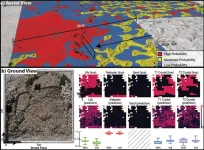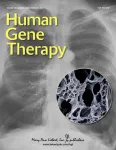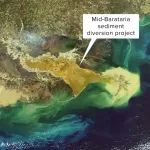(Press-News.org) INDIANAPOLIS -- LOINC® from Regenstrief Institute is issuing its semi-annual release, which contains 608 new concepts to help health systems, laboratories and other health organizations accurately exchange medical data. Some of the new information has been released in coordination with the U.S. Food and Drug Administration, the U.S. Centers for Disease Control and Prevention and the Association of Public Health Laboratories.
“Aligning the release of LOINC with emerging healthcare trends is an important component of our mission and critical in promoting effective health information exchange among providers, patients and health systems,” said Marjorie Rallins, DPM, M.S., executive director of LOINC and Health Data Standards for Regenstrief. “Keeping communication channels open with key stakeholders ensures LOINC remains responsive and relevant. Early and ongoing collaboration with federal agencies and national and international partners provides efficiencies by inclusion.”
Of the new concepts, 464 are focused on laboratory, 95 are focused on clinical and 49 are focused on surveys. LOINC version 2.74 prioritized concepts are centered around Lyme disease, the monkeypox virus, evaluation methods related to the SARS-Cov-2 virus and identifying bacteria, viruses and fungi in veterinary specimens.
LOINC, short for Logical Observation Identifiers Names and Codes, is a universal language used to identify test results, observations and other health information, making it more easily exchanged and understood between laboratories, health systems and public health organizations. LOINC has users from nearly every country. It has been especially important during the global pandemic, allowing the exchange of COVID-related data across borders and languages.
Regenstrief Institute releases updates to LOINC twice per year, in February and August.
Webinar to assist users
A brief webinar will follow the first release of the year a few weeks after publication in February. The webinar for the LOINC 2.74 release is scheduled for 10-11:30 a.m. EDT (14:00-15:30 UTC) on March 28, 2023 (2023-03-28).
This educational webinar provides opportunities for the LOINC community to learn more about each release and ask questions of the LOINC team. This dedicated event is also the LOINC team’s opportunity to announce plans for the year. The August release discussion is included as part of the larger, in-person and online LOINC Conference in the fall.
The webinar will be available later online here: https://loinc.org/webinar/.
About LOINC®
LOINC was created in 1994 at Regenstrief Institute in an effort to facilitate interoperability in healthcare. Today, the LOINC coding system contains about 100,000 terms for everything from a serum alpha 1 antitrypsin level to a zygomatic arch x-ray report. For each concept, LOINC covers many other rich details, such as synonyms, units of measure and carefully crafted descriptions.
About Regenstrief Institute
Founded in 1969 in Indianapolis, the Regenstrief Institute is a local, national and global leader dedicated to a world where better information empowers people to end disease and realize true health. A key research partner to Indiana University, Regenstrief and its research scientists are responsible for a growing number of major healthcare innovations and studies. Examples range from the development of global health information technology standards that enable the use and interoperability of electronic health records to improving patient-physician communications, to creating models of care that inform practice and improve the lives of patients around the globe.
Sam Regenstrief, a nationally successful entrepreneur from Connersville, Indiana, founded the institute with the goal of making healthcare more efficient and accessible for everyone. His vision continues to guide the institute’s research mission.
END
LOINC continues facilitating health data interoperability with biannual issuance of new concepts
Updates include coordination with FDA, CDC, APHL
2023-03-06
ELSE PRESS RELEASES FROM THIS DATE:
New study uncovers key culprit behind pediatric brain cancer metastasis
2023-03-06
New research pinpoints a key cause of metastasis from an aggressive form of brain cancer in children and provides a potential new therapy for treating these tumors in the future.
In a paper, published in Nature Cell Biology, physician-scientists from the University of Pittsburgh and UPMC Children’s Hospital of Pittsburgh discovered that medulloblastomas hijack a skill that normal brain cells use during their early development and then manipulate it to help tumors spread.
“Children with medulloblastomas that have not yet metastasized may have a high likelihood of long-term survival, but if ...
Can artificial intelligence help find life on Mars or icy worlds?
2023-03-06
March 6, 2023, Mountain View, CA – Wouldn’t finding life on other worlds be easier if we knew exactly where to look? Researchers have limited opportunities to collect samples on Mars or elsewhere or access remote sensing instruments when hunting for life beyond Earth. In a paper published in Nature Astronomy, an interdisciplinary study led by SETI Institute Senior Research Scientist Kim Warren-Rhodes, mapped the sparse life hidden away in salt domes, rocks and crystals at Salar de Pajonales at the boundary of the Chilean Atacama Desert and Altiplano. Then they trained a machine learning model to recognize the patterns and rules associated with their distributions ...
Geosciences at the Crossroads of America
2023-03-06
Boulder, Colo., USA: Oklahoma State University is hosting the 57th annual meeting of the Geological Society of America’s South-Central Section on 13–14 March. The meeting will have a diverse program of workshops, technical sessions, short courses, and field trips that covers a spectrum of geologic disciplines.
The list below highlights a selection of environmental-related session topics you might like:
· Tar Creek Superfund Site Field Trip (Field Trip)
Managed Aquifer Recharge in the Arbuckle Simpson Aquifer (Field Trip)
Geoscience Career Workshop: Career Planning and Networking
· Hydrogeologic Challenges and Roles ...
Gene and cell therapies to combat pancreatic cancer
2023-03-06
Pancreatic cancer is an incurable form of cancer, and gene therapies are currently in clinical testing to treat this deadly disease. A comprehensive review of the gene and cell biotherapies in development to combat pancreatic cancer is published in the peer-reviewed journal Human Gene Therapy. Click here to read the article now
The article titled “Pancreatic Cancer Cell and Gene Biotherapies: Past, Present and Future,” contributed by corresponding author Pierre Cordelier, from the University of Toulouse, and coauthors, ...
Oncotarget | HALP score: Prognostic ability in cancers - a literature review
2023-03-06
“In the last several years, the Hemoglobin, Albumin, Lymphocyte, Platelet Score (HALP) has emerged in the literature as a new prognostic biomarker [...]”
BUFFALO, NY- March 6, 2023 – A new review paper was published in Oncotarget's Volume 14 on February 25, 2023, entitled, “What is hemoglobin, albumin, lymphocyte, platelet (HALP) score? A comprehensive literature review of HALP’s prognostic ability in different cancer types.”
Since its inception, the Hemoglobin, Albumin, Lymphocyte, Platelet (HALP) Score has gained attention as a new prognostic biomarker to predict several clinical outcomes in a multitude ...
Nationwide study finds that women have greater risk of mortality than men after coronary artery bypass surgery
2023-03-06
Compared with men, women continue to have a roughly 30-40 percent higher risk of dying following coronary artery bypass surgery, according to a large study led by investigators at Weill Cornell Medicine and NewYork-Presbyterian/Weill Cornell Medical Center. The analysis showed that, without adjusting for differences in age and other health factors that influence risk, the female bypass patients had a 2.8 percent rate of death during or soon after surgery, compared with 1.7 percent for male patients, a nearly 50 percent difference that only dropped 10-20 percent after accounting for these factors.
The study, which appears Mar. 1 in JAMA Surgery, was based on ...
Assessing the risk of excess folic acid intake
2023-03-06
It is well established that folic acid supplementation can significantly reduce the risk of birth defects, including neural tube defects like spina bifida, the most common birth defect of the central nervous system and the second most common of all structural birth defects. More than 80 nations, including the U.S. 25 years ago, have established mandated folic acid food fortification programs, which have been successful.
“However, there is a lack of research on whether excessive folic acid intake has the potential ...
Geisinger study supports genetic testing for people with cerebral palsy
2023-03-06
DANVILLE, Pa. – A Geisinger meta-analysis of recent research on the genetics of cerebral palsy (CP) provides evidence that genetic testing should be offered as the standard of care for people with the disorder, similar to current recommendations for individuals with other neurodevelopmental disorders (NDD). The findings were published Tuesday in JAMA Pediatrics.
Individual cases of CP—a condition that affects movement, balance and posture—have often been attributed to birth asphyxia, although recent studies show that asphyxia accounts for less than 10% of cases. A growing body of evidence suggests that a significant proportion of CP is caused by genetic changes, ...
New Geology articles published online ahead of print
2023-03-06
Boulder, Colo., USA: Article topics and locations include the Red Lake greenstone belt, Canada; Anak Krakatau volcano, Indonesia; martian soil; Glacial Lake Missoula, Montana, USA; and findings from IODP Expedition 385. These Geology articles are online at https://geology.geoscienceworld.org/content/early/recent .
Crustal conductivity footprint of the orogenic gold district in the Red Lake greenstone belt, western Superior craton, Canada
Ademola Q. Adetunji; Gaetan Launay; Ian J. Ferguson; Jack M. Simmons; Chong Ma ...
A magnetotelluric (MT) study across the Red Lake greenstone belt of the ...
Mississippi River Delta study reveals which human actions contribute to land loss
2023-03-06
BLOOMINGTON, Ind. — Research from scientists at Indiana University and Louisiana State University reveals new information about the role humans have played in large-scale land loss in the Mississippi River Delta — crucial information in determining solutions to the crisis.
Published in Nature Sustainability, the study compares the impacts of different human actions on land loss and explains historical trends. Until now, scientists have been unsure about which human-related factors are the most consequential, and why ...
LAST 30 PRESS RELEASES:
Exploring how the visual system recovers following injury
Support for parents with infants at pediatric check-ups leads to better reading and math skills in elementary school
Kids’ behavioral health is a growing share of family health costs
Day & night: Cancer disrupts the brain’s natural rhythm
COVID-19 vaccination significantly reduces risk to pregnant women and baby
The role of vaccination in maternal and perinatal outcomes associated with COVID-19 in pregnancy
Mayo Clinic smartwatch system helps parents shorten and defuse children's severe tantrums early
Behavioral health spending spikes to 40% of all children’s health expenditures, nearly doubling in a decade
Digital cognitive behavioral treatment for generalized anxiety disorder
Expenditures for pediatric behavioral health care over time and estimated family financial burden
Air conditioning in nursing homes and mortality during extreme heat
The Alps to lose a record number of glaciers in the next decade
What makes a good proton conductor?
New science reporting guide published for journalists in Bulgaria
New international study reveals major survival gaps among children with cancer
New science reporting guide published for journalists in Turkey
Scientists develop a smarter mRNA therapy that knows which cells to target
Neuroanatomy-informed brain–machine hybrid intelligence for robust acoustic target detection
Eight SwRI hydrogen projects funded by ENERGYWERX
The Lundquist Institute and its start-up company Vitalex Biosciences Announces Strategic Advancement of Second-Generation fungal Vaccine VXV-01 through Phase 1 Trials under $40 Million Competitive Con
Fine particles in pollution are associated with early signs of autoimmune disease
Review article | Towards a Global Ground-Based Earth Observatory (GGBEO): Leveraging existing systems and networks
Penn and UMich create world’s smallest programmable, autonomous robots
Cleveland researchers launch first major study to address ‘hidden performance killer’ in athletes
To connect across politics, try saying what you oppose
Modulating key interaction prevents virus from entering cells
Project explores barriers to NHS career progression facing international medical graduates
Jeonbuk National University researchers explore the impact of different seasonings on the flavor perception of Doenjang soup
Two Keck Medicine of USC Hospitals named Leapfrog Top Teaching Hospitals
World-first discovery uncovers how glioblastoma tumours dodge chemotherapy, potentially opening the door to new treatments
[Press-News.org] LOINC continues facilitating health data interoperability with biannual issuance of new conceptsUpdates include coordination with FDA, CDC, APHL




